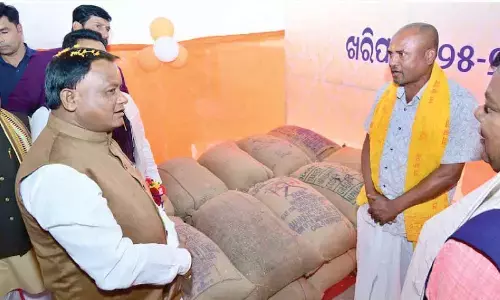Quantitative Easing and helicopter money

Ever since Chief Minister of Telangana K Chandrashekar Rao in his press meet on April 11 made a mention to Quantitative Easing (QE) and helicopter money, the words have become so popular that, even an illiterate and novice also started talking of them. Chandrashekar Rao categorically said, "In this critical time, we should think of a solution and QE is the only way to make the country out of this crisis," and added that since money comes as an aid from the sky, it is called helicopter money and generally the Central reserve banks resort to this method to revive the economies of countries in large economic crises.
Chandrashekar Rao addressed a letter to Prime Minister Narendra Modi soon after the Cabinet meeting held on that day. In the letter he mentioned that, "All over the world, the Central banks have taken very bold measures to counter the global recession which is worse than the great depression of 1929 and global financial crisis of 2008. Distressed times need desperate measures. The only way to counter the impending recession is through Quantitative Easing (QE) and the effective use of helicopter money. This approach is being followed by all major central banks of the world namely, Federal Reserve of USA, European Central Bank, Bank of England, Bank of Japan, People's Bank of China, Central Bank of Russia, Bank of Canada and Reserve Bank of Australia. Quantitative Easing proposed should be at least 5% of GDP of the country. The 2019-20 GDP of India is 203.85 lakh crores and the QE at 5% works out to be Rs 10.15 lakh crores.
QE, also known as large-scale asset purchases, is a monetary policy whereby a country's Central bank, like the Reserve Bank of India, buys predetermined amounts of government bonds or other financial assets in order to add money directly into the economy. It is a monetary policy established by Central banks in which newly created money is used to buy state debts and once the period of QE ends, these capital flows may reverse, leaving behind a stock of unpayable debts.
Quantitative Easing can fuel economic growth since money funnelled into the economy should allow people to more comfortably make purchases. This can have a trickledown effect on both the consumer and business communities, leading to increased stock market performance and GDP growth. The problem is that the money created through QE is used to buy government bonds from the financial markets. The newly created money therefore may go directly into the financial markets, boosting bond and stock markets nearly to their highest level in history.
The end of QE may be deflationary. The goal of QE policies is to boost economic activity by providing liquidity to the financial system. But Quantitative Easing may cause higher inflation than desired if the amount of easing required is overestimated and too much money is created by the purchase of liquid assets. On the other hand, QE can fail to spur demand if banks remain reluctant to lend money to businesses and households.
If Central banks increase the money supply, it can cause inflation. In a worst-case scenario, the Central bank may cause inflation through QE without economic growth, causing a period of so-called stagflation. Quantitative easing has been nicknamed "printing money" by some members of the media, Central bankers, and financial analysts. With QE, the newly created money is usually used to buy financial assets other than government bonds.
According to USA economy expert, Kimberly Amadeo, the President of World Money Watch, Japan was the first to use QE from 2001 to 2006. It restarted in 2012 with the election of Shinzo Abe as Prime Minister. The US Federal Reserve undertook the most successful QE effort in 2008. It added almost $2 trillion to the money supply. That's the largest expansion from any economic stimulus program in history. The European Central Bank adopted QE in January 2015 after seven years of austerity measures.
Quantitative easing also stimulates the economy in another way. Past experience proved that, QE achieved some of its goals, missed others completely, and created several asset bubbles. It helped to stabilise the economy, providing the funds and the confidence to pull out of the recession. It keeps the interest rates low enough to revive the housing market.
It stimulated economic growth, although probably not as much as expected. It didn't achieve the goal of making more credit available. It gave the money to banks, but the banks sat on the funds instead of lending them out. Banks used the funds to triple their stock prices through dividends and stock buybacks. As feared, QE did not cause widespread inflation. If banks had lent out the money, businesses would have increased operations and hired more workers.
Helicopter money is the term used for a large sum of new money that is printed and distributed among the public, to stimulate the economy during a recession or when interest rates fall to zero. It is also referred to as a helicopter drop, in reference to a helicopter scattering supplies from the sky. This is an unconventional monetary policy tool aimed at bringing a flagging economy back on track. American economist Milton Friedman coined this term. Friedman used the term to signify "unexpectedly dumping money onto a struggling economy with the intention to shock it out of a deep slump. "Under such a policy, a Central bank directly increase the money supply and, via the government, distribute the new cash to the population with the aim of boosting demand and inflation."
Quantitative easing also involves the use of printed money by Central banks to buy government bonds. But not everyone views the money used in QE as helicopter money. It's not the same as bond-buying by Central banks "in which bank-owned assets are swapped for new Central bank reserves." Helicopter money is also different from a Central bank directly financing the debt of a government.
According to Arvind Subramanian, former Economic Advisor to the Prime Minister, Quantitative easing has generally, and on balance, had a positive impact on emerging markets (EMs) and the global economy. But in some instances, they have added to pressures and volatility for EMs, complicating macro-economic management, and the impact has depended significantly on the global macroeconomic situation as well as the situation in particular countries. Arvind Subramanian once testified before the US House Committee on Monetary Policy and Trade and shared his thoughts on the international impacts of the Federal Reserve's quantitative easing programme.
QE has its own advantages and disadvantages in the Indian context. In an economy like the present Indian scenario and the possible impending crisis, it enables adequate money into circulation. It ensures brisk economic activity, increases purchasing power, facilitates reserve of enough money with the government and enhancement of borrowing capacity as well as spending power. The disadvantage is, in consonance with the money in circulation, if the production is not increased, not only the purchase capacity falls down but also leads to inflation.
Against this background, despite a few disadvantages, it is positively a good suggestion by K Chandrashekar Rao to Prime Minister Modi to prefer Quantitative Easing (QE) and helicopter money to counter the impending recession caused due to unprecedented countrywide coronavirus spread.
(The writer is Chief Public Relations Officer to the Chief Minister of Telangana. Views expressed are personal)


















